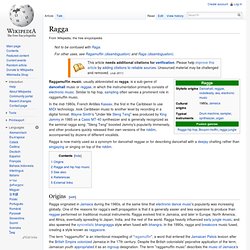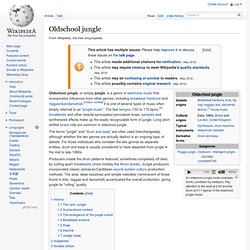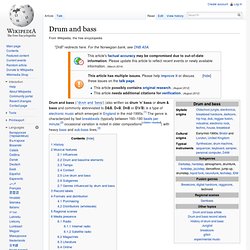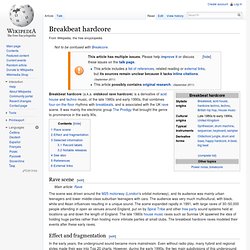

Ragga. Origins[edit] The term "raggamuffin" is an intentional misspelling of "ragamuffin", a word that entered the Jamaican Patois lexicon after the British Empire colonized Jamaica in the 17th century.

Despite the British colonialists' pejorative application of the term, Jamaican youth appropriated it as an ingroup designation. The term "raggamuffin music" describes the music of Jamaica's "ghetto dwellers". Ragga and hip hop music[edit] Some ragga artists believe that the assimilation of hip hop sensibilities is crucial to the international marketability of dancehall music.
See also[edit] References[edit] The world of DJs and the turntable culture By Todd SouvignierStascha (Staša) Bader: Worte wie Feuer: Dancehall Reggae und Raggamuffin. External links[edit] Allmusic entry for Ragga. Oldschool jungle. An oldschool jungle music example (here, Levitation by oedipax).

Pay attention to the lead at 0:00 and the drum at 0:11 typical of the oldschool jungle music. The terms "jungle" and "drum and bass" are often used interchangeably, although whether the two genres are actually distinct is an ongoing topic of debate. For those individuals who consider the two genres as separate entities, drum and bass is usually considered to have departed from jungle in the mid to late-1990s. History[edit] Jazzstep music - Listen free at Last.fm. Downloads, Mix Sets, Mp3 Music, Radio, News. Liquid funk.
Liquid funk (alternatively, liquid drum & bass, liquid DnB or liquid) is a sub-genre of drum and bass.

While it uses similar basslines and bar layouts to other styles, it contains fewer bar-oriented samples and more instrumental layers (both synthesized and natural), harmonies, melodies and ambiance, producing a sentimental atmosphere directed at home listeners as well as nightclub and rave audiences. Music genres such as jazz, soul and sometimes blues has a pivotal influence on liquid funk.
Drum and bass. History[edit] In the late 1980s and early 1990s, a growing nightclub and overnight outdoor event culture gave birth to a new electronic music style called rave music, which, much like hip-hop, combined sampled syncopated beats or breakbeats, other samples from a wide range of different musical genres and, occasionally, samples of music, dialogue and effects from films and television programmes.

But rave music tended to feature stronger bass sounds and a faster tempo (127 to over 140) beats per minute (BPM) than that of early house music. Jump-Up (electronic music) Neurofunk. Overview[edit] Psycho album by Phace on Subtitles (2007).

As the subgenre developed, with artists starting as purists and later changing their musical direction into broader musical settings, so new artists have emerged to fill the vacuum, re-energizing the sound by taking production back to its roots. Lyrical content[edit] "We Enter" (Optical Remixes) by Ryme Tyme on No U-Turn (1999). Matrix & Fierce - "Tightrope/Climate" 12" single on Metro (2000). As an MC and lyricist, Ryme Tyme played the neurofunk style as an integral member of Ed Rush & Optical's live, DJ sets and studio sessions. Trancestep. Breakbeat hardcore. Not to be confused with Breakcore.

Rave scene[edit] The scene was driven around the M25 motorway (London's orbital motorway), and its audience was mainly urban teenagers and lower middle-class suburban teenagers with cars. The audience was very much multicultural, with black, white and Asian influences resulting in a unique sound. The scene expanded rapidly in 1991, with large raves of 30–50,000 people attending in open air venues around England, put on by Spiral Tribe and other free party sound systems held at locations up and down the length of England.
The late 1980s house music raves such as Sunrise UK spawned the idea of holding huge parties rather than hosting more intimate parties at small clubs. Darkcore. Darkcore is a music subgenre of jungle (not be confused with the more recent developments of hardcore) that became popular in the United Kingdom.

It is recognized as being one of the direct precursors of the genre now known as drum and bass. Darkcore was a counter movement to happy, which also evolved from breakbeat hardcore. The name was most likely derived from the track "Darkcore" by Two Dark Troopers, released on Basement Records in 1993. Techstep.
Hardstep. Hardstep (not to be confused with Hard D'n'B or the more recent Drum and Bass/Hardstyle known as Drumstyle) is a subgenre of Drum and bass which emerged in 1994. [1] It is characterised by a gritty production style, that has an inner-city feel to it.

The breaks are less cut-up sounding rather than oldschool jungle, and have faster and harder simple electronic melodies. One characteristic is an accentuated, yet sparse percussive beat. [2] The genre found favour with junglists, despite being overtaken in popularity by techstep, the fans of the style still remain. Nowadays Hardstep is particularly popular in the North American drum and bass scene, with artist like Evol Intent, Ewun and Dieselboy. Earlier Hardstep artists include DJ Hype and DJ Zinc.[3]